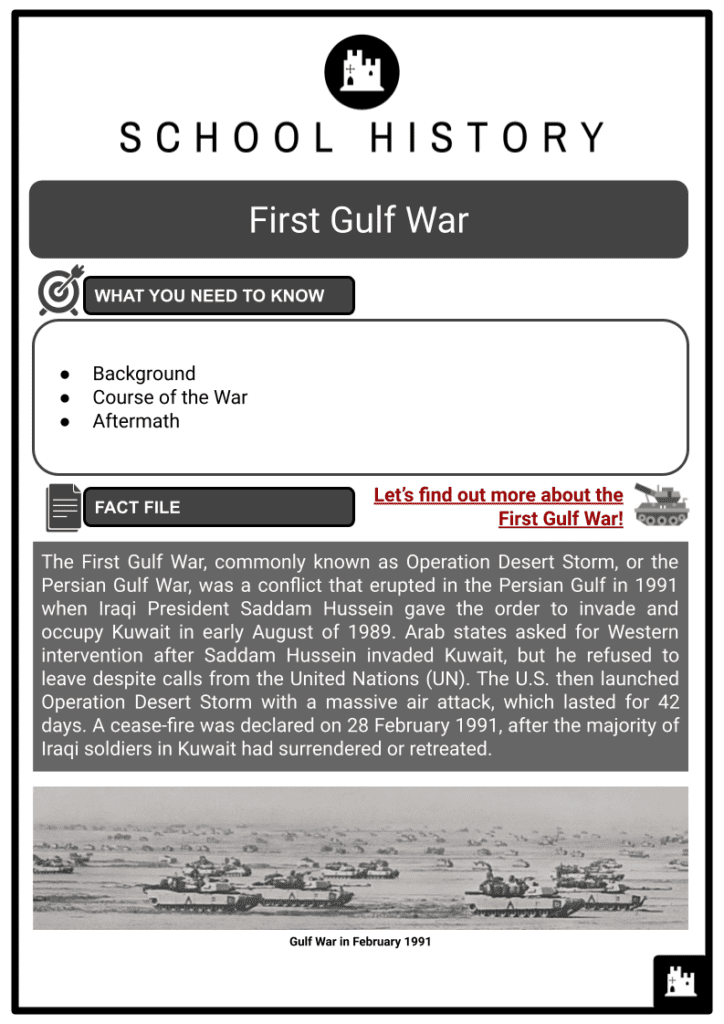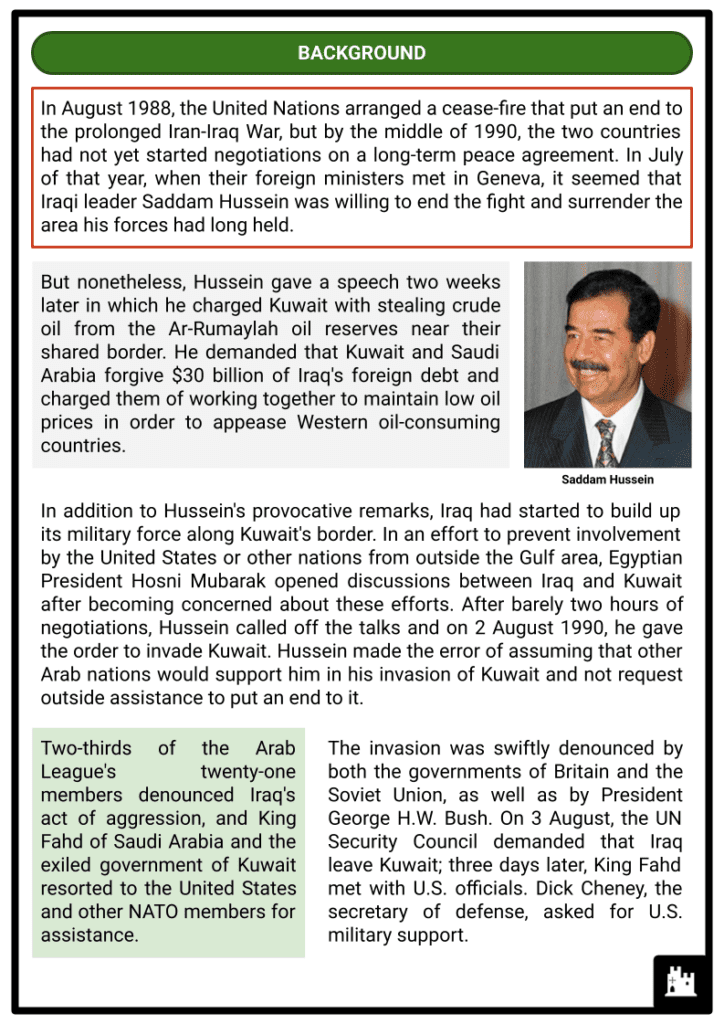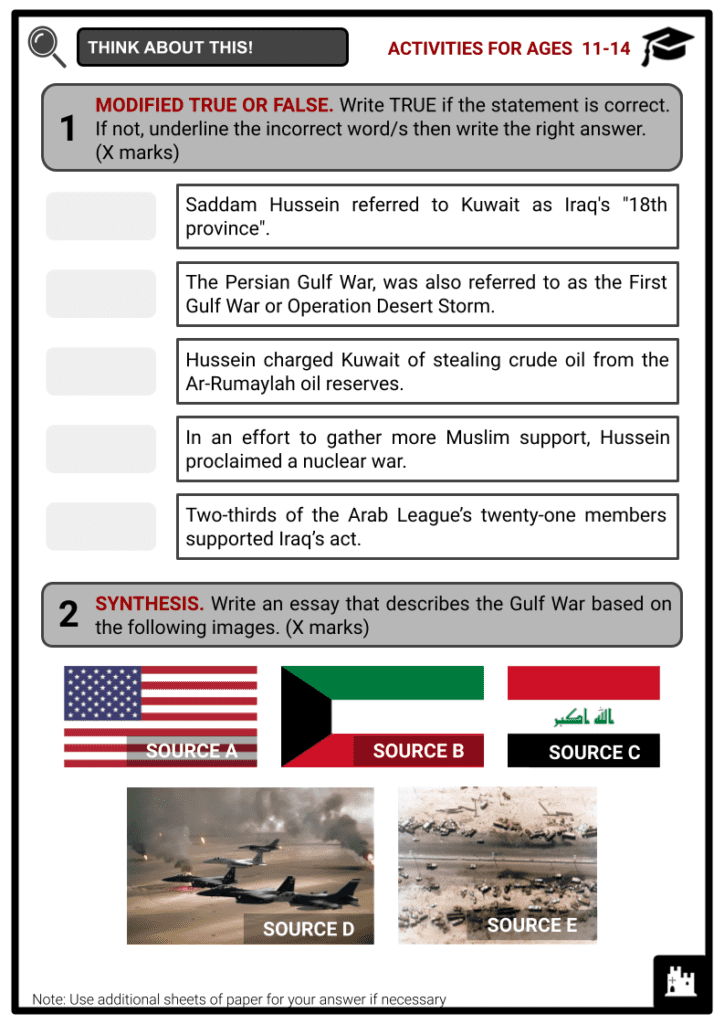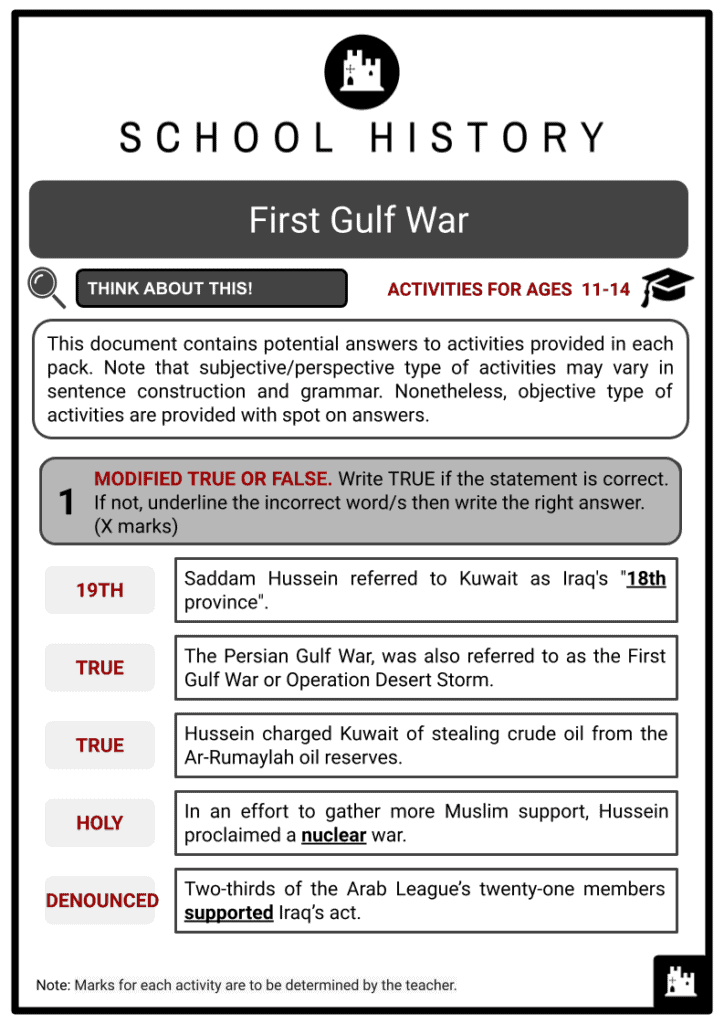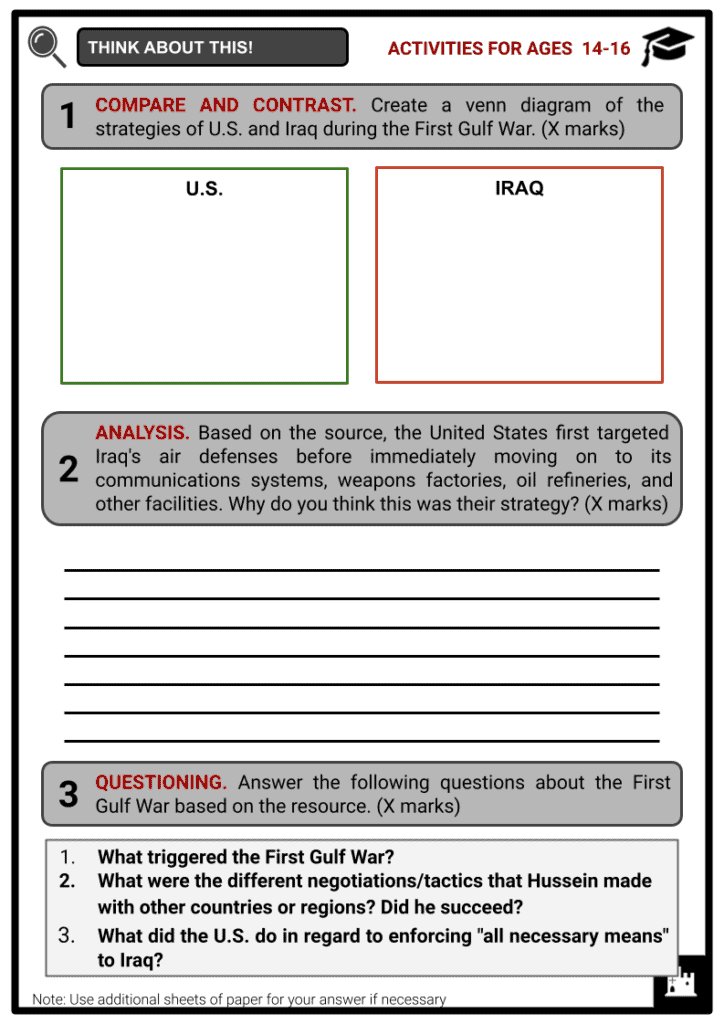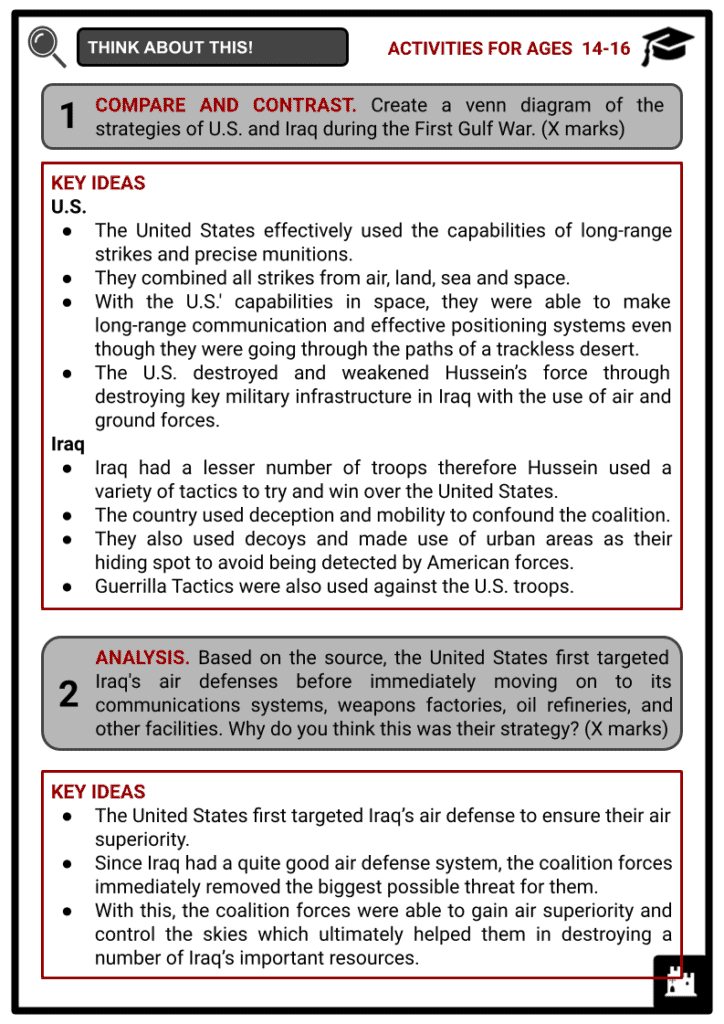First Gulf War Worksheets
Do you want to save dozens of hours in time? Get your evenings and weekends back? Be able to teach about the First Gulf War to your students?
Our worksheet bundle includes a fact file and printable worksheets and student activities. Perfect for both the classroom and homeschooling!
Summary
- Background
- Course of the War
- Aftermath
Key Facts And Information
Let’s find out more about the First Gulf War!
The First Gulf War, commonly known as Operation Desert Storm, or the Persian Gulf War, was a conflict that erupted in the Persian Gulf in 1991 when Iraqi President Saddam Hussein gave the order to invade and occupy Kuwait in early August of 1989. Arab states asked for Western intervention after Saddam Hussein invaded Kuwait, but he refused to leave despite calls from the United Nations (UN). The U.S. then launched Operation Desert Storm with a massive air attack, which lasted for 42 days. A cease-fire was declared on 28 February 1991, after the majority of Iraqi soldiers in Kuwait had surrendered or retreated.

BACKGROUND
- In August 1988, the United Nations arranged a cease-fire that put an end to the prolonged Iran-Iraq War, but by the middle of 1990, the two countries had not yet started negotiations on a long-term peace agreement. In July of that year, when their foreign ministers met in Geneva, it seemed that Iraqi leader Saddam Hussein was willing to end the fight and surrender the area his forces had long held.
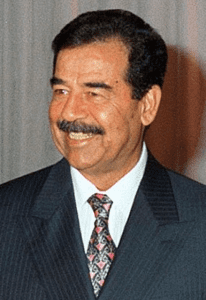
Saddam Hussein - But nonetheless, Hussein gave a speech two weeks later in which he charged Kuwait with stealing crude oil from the Ar-Rumaylah oil reserves near their shared border. He demanded that Kuwait and Saudi Arabia forgive $30 billion of Iraq's foreign debt and charged them of working together to maintain low oil prices in order to appease Western oil-consuming countries.
- In addition to Hussein's provocative remarks, Iraq had started to build up its military force along Kuwait's border. In an effort to prevent involvement by the United States or other nations from outside the Gulf area, Egyptian President Hosni Mubarak opened discussions between Iraq and Kuwait after becoming concerned about these efforts. After barely two hours of negotiations, Hussein called off the talks and on 2 August 1990, he gave the order to invade Kuwait. Hussein made the error of assuming that other Arab nations would support him in his invasion of Kuwait and not request outside assistance to put an end to it.
- Two-thirds of the Arab League's twenty-one members denounced Iraq's act of aggression, and King Fahd of Saudi Arabia and the exiled government of Kuwait resorted to the United States and other NATO members for assistance.
- The invasion was swiftly denounced by both the governments of Britain and the Soviet Union, as well as by President George H.W. Bush. On 3 August, the UN Security Council demanded that Iraq leave Kuwait; three days later, King Fahd met with U.S. officials. Dick Cheney, the secretary of defense, asked for U.S. military support.
- On 8 August, the day Kuwait was formally taken by the Iraqi government (Hussein referred to it as Iraq's "19th province"), the first U.S. Air Force fighter aircraft, as part of a military buildup known as Operation Desert Shield, arrived in Saudi Arabia. In order to deter a potential Iraqi attack on Saudi Arabia, NATO allies, Egypt, and a number of other Arab countries dispatched soldiers along with the U.S. bombers.
- Iraq expanded the number of its occupying troops in Kuwait to over 300,000. Hussein proclaimed a jihad, or holy war, against the coalition in an effort to gather more Muslim support. He also made an attempt to help the Palestinian cause by proposing to leave Kuwait in exchange for an Israeli departure from the occupied areas. After these attempts failed, Hussein hurriedly reached a truce with Iran in order to re-assemble his army.
COURSE OF THE WAR
- The UN resolution issued on 29 November 1990, authorised the use of "all necessary means" of force if Iraq did not leave Kuwait by 15 January 1991. By January, there were approximately 750,000 soldiers in the coalition forces, including 540,000 Americans and others from the Soviet Union, Japan, Egypt, Britain, France, and Saudi Arabia.
- The Gulf War began with an extensive aerial bombing campaign that lasted 42 days and nights, during which the coalition forces unleashed 88,500 tonnes of bombs on Iraq, devastating both military and civilian facilities. The air campaign targeted Iraq's air force, anti-aircraft sites, and command and communication infrastructure to deprive Iraqi troops of their ability to command and manage their forces.
- The third phase of the air campaign targeted naval forces, Scud missile launchers, weapons research facilities, and other military targets throughout Kuwait and Iraq. Iraqi anti-aircraft defenses caused the loss of only 75 coalition aircrafts, with 44 of the losses attributable to Iraqi action.
- Despite receiving significant assistance from its neighbours, including Jordan, Algeria, Sudan, Yemen, Tunisia, and the Palestine Liberation Organisation (PLO), the coalition forces had major technological and military superiority. On 17 January 1991, the coalition began Operation Desert Storm in an effort to seriously undermine Iraq's military prowess.
- On 29 January 1991, Iraqi forces attacked and occupied the Saudi Arabian city of Khafji but were driven back two days later by allied forces.
- The battle resulted in casualties on both sides, with the Iraqi forces sustaining substantially more dead and captured than the allied forces.
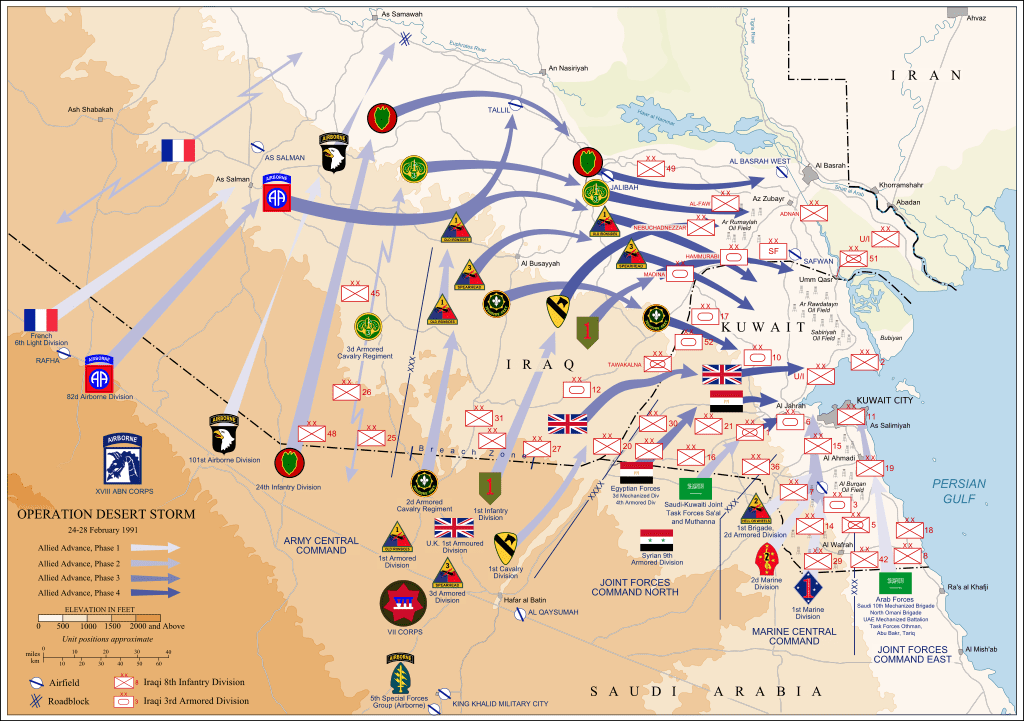
Ground troop movements on February 1991 - The Battle of Khafji demonstrated the effectiveness of air power in hindering the advance of enemy ground forces, as 140 coalition aircrafts were able to attack an advancing column of Iraqi armoured divisions, resulting in significant vehicle losses and preventing an organised attack on the town.
- As they were unable to match the coalition's air power, the Iraqi air force either suffered early devastation or opted to avoid combat. By mid-February, the coalition began targeting Iraqi ground forces in Kuwait and southern Iraq with airstrikes. Soldiers moved into Kuwait and southern Iraq as part of Operation Desert Sabre, a large allied ground assault that began on 24 February 1991.
- Kuwait was liberated when coalition forces encircled and crushed Iraqi forces over four days, from 24 February to 28 February. At the same time, a rear-attack on Iraq's armoured reserves was launched as U.S. troops invaded the country from the west. In southeast Iraq, the elite Iraqi Republican Guard mounted a struggle, but by 27 February, they had been overwhelmed and vanquished.
AFTERMATH
- In 1991, a cease-fire was declared and the United Nations Security Council adopted a resolution imposing severe economic penalties on Iraq until it complied with the peace agreement provisions, including the elimination of all weapons of mass destruction (WMDs) and weapons programs.
- UN weapons inspectors went to Iraq to verify compliance, but Iraq routinely interfered with these inspections, escalating hostilities between Iraq and the UN.
- In 1998, when Iraq stopped working with UN weapons inspectors, the United States and the United Kingdom began Operation Desert Fox, a four-day bombing assault against Iraqi sites.
- The conflict had long-lasting consequences for the Persian Gulf area and the rest of the globe. In the immediate aftermath of the war, Kurdish uprisings in the north of Iraq and Shi'ite uprisings in the south were ruthlessly suppressed by Hussein's forces.
- The coalition decided not to assist them because of concerns that the uprisings might destabilise the Iraqi state if they were successful. U.S. and British planes continued to monitor the skies over Iraq in the years that followed, while Iraqi officials made every attempt to thwart the implementation of the peace accords, particularly United Nations weapons inspections.
- In 1998, hostilities briefly resumed as a result of Iraq's persistent refusal to allow weapons inspectors. American and British planes frequently engaged in gunfire exchanges with Iraqi forces over the no-fly zone.
- The invasion overthrew Saddam Hussein's administration, but it also brought about years of sectarian conflict and instability in Iraq, causing serious political, economic, and social repercussions in Iraq, the Middle East, and the rest of the world.

